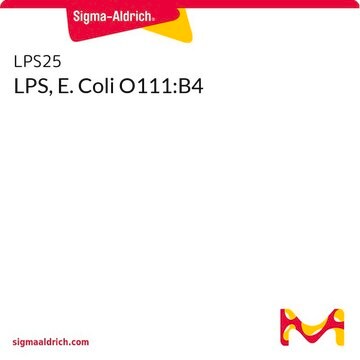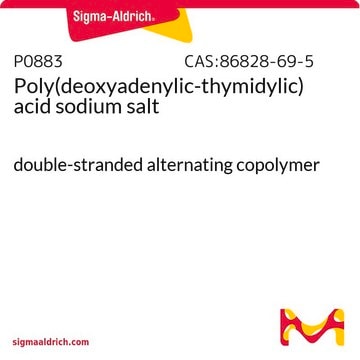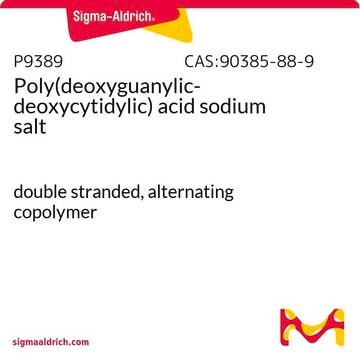P1038
Poly(cytidylic-inosinic) acid potassium salt
random copolymer
Synonym(s):
Poly (C,I)
Sign Into View Organizational & Contract Pricing
All Photos(2)
About This Item
Recommended Products
Application
Poly(cytidylic-inosinic) acid potassium salt has been used:
- in pretreatment to understand Con A-induced hepatitis in mice
- in RNA extraction from hemolymph plasma for qPCR detection assay
- to induce inflammatory changes in liver
- as a component of minimal essential medium for the stimulation of rainbow trout gonad line RTG-2 cells
Biochem/physiol Actions
Poly(cytidylic-inosinic) Poly(C,I) is a random copolymer of inosine and cytidine bases which may be useful for comparative physicochemical analysis versus other random copolymers such as Poly(C,A), Poly(C,U) and Poly(C,G).
Poly(cytidylic-inosinic) acid, poly I:C mimics viral RNA to induce immune response. Administration of poly I:C promotes cytotoxic functionality of natural killer cells and macrophages. However, poly I:C may trigger generation of anti-mitochondrial antibodies (AMAs) and contribute to the pathogenesis of primary biliary cirrhosis (PBC). Poly I:C may play a hepatoprotective role in Con A-induced T cell-dependent liver injury.
Other Notes
Random copolymer
Storage Class Code
11 - Combustible Solids
WGK
WGK 3
Flash Point(F)
Not applicable
Flash Point(C)
Not applicable
Personal Protective Equipment
dust mask type N95 (US), Eyeshields, Gloves
Choose from one of the most recent versions:
Certificates of Analysis (COA)
Lot/Batch Number
Don't see the Right Version?
If you require a particular version, you can look up a specific certificate by the Lot or Batch number.
Already Own This Product?
Find documentation for the products that you have recently purchased in the Document Library.
Customers Also Viewed
G F Joyce et al.
Journal of molecular biology, 176(2), 279-306 (1984-06-25)
Poly(C, U) random copolymer templates direct the oligomerization of 2-MeImpG and 2-MeImpA, resulting in the production of a variety of oligo/(G,A)s. The efficiency of monomer incorporation into newly synthesized oligomers is greater for 2-MeImpG than for 2-MeImpA, and decreases for
G F Joyce et al.
Journal of molecular biology, 202(3), 677-681 (1988-08-05)
Poly(C,A) random copolymer templates direct the oligomerization of 2-MeImpG (2-MeImpX is the 5'-phospho-2-methylimidazolide of the nucleoside X) and 2-MeImpU, resulting in the production of a variety of oligo (G,U)s. This reaction is less efficient than comparable reactions involving poly(C,U) or
The multi-hit hypothesis of primary biliary cirrhosis: polyinosinic-polycytidylic acid (poly I: C) and murine autoimmune cholangitis
Wang J, et al.
Journal of Hepatology, 44(3), 446-454 (2006)
Persistence of double-stranded RNA in insect hemolymph as a potential determiner of RNA interference success: evidence from Manduca sexta and Blattella germanica
Garbutt JS, et al.
Journal of Insect Physiology, 59(2), 171-178 (2013)
G F Joyce et al.
Journal of molecular biology, 188(3), 433-441 (1986-04-05)
Poly(C, G) random copolymer templates direct the oligomerization of 2-Me-ImpG and 2-MeImpC, resulting in the production of a variety of oligo(G, C)s. The efficiency of monomer incorporation into newly synthesized oligomers is greater for 2-MeImpG than for 2-MeImpC, and decreases
Our team of scientists has experience in all areas of research including Life Science, Material Science, Chemical Synthesis, Chromatography, Analytical and many others.
Contact Technical Service












